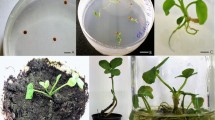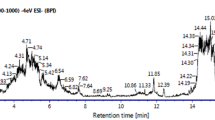Abstract
Opuntia humifusa, a member of the Cactaceae family widely distributed in the southern regions of the Korean peninsula, has potential bioactive functions and medicinal benefits. In the present study, we investigated the effect of hexane, ethyl acetate extracts and water partitioned fraction of O. humifusa on proliferation, G1 arrest and apoptosis in U87MG human glioblastoma cells. Glioblastoma cellular proliferation was evaluated using the MTT (3-(4,5-dimethylthiazol-2-yl)-2,5-diphenyltetrazolium bromide) assay, and the effects of O. humifusa partitioned extracts on cell cycle and apoptosis were analyzed by flow cytometry. Our results revealed that when U87MG cells were treated with hexane extracts and water partitioned fraction of O. humifusa, the number of viable cells decreased in a concentration-dependent manner. In addition, water partitioned fractions of O. humifusa induced G1 arrest and non-apoptotic cell death as well as significant increases in ROS production in U87MG cells. In conclusion, water partitioned fractions of O. humifusa induce G1 arrest and inhibit U87MG human glioblastoma cell proliferation.






Similar content being viewed by others
Abbreviations
- EtOAc:
-
Ethyl acetate
- MTT:
-
3-(4,5-dimethylthiazol-2-yl)-2,3 diphenyltetrazolium bromide
- ROS:
-
Reactive oxygen species
- U87MG:
-
Human glioblastoma-human cancer cell line
References
Boudreau CR, Yang I, Liau LM (2005) Gliomas advances in molecular analysis and characterization. Surg Neurol 64:286–294
Glinski B, Dymek P, Skolyszewski J (1998) Altered therapy schedules in postoperative treatment of patients with malignant gliomas: twenty year experience of the Maria Sklodowska-Curie Memorial Center in Krakow, 1973–1993. J Neurooncol 36:159–165
Curtin JF, King GD, Candolfi M, Greeno RB, Kroeger KM, Lowenstein PR, Castro MG (2005) Combining cytotoxic and immune-mediated gene therapy to treat brain tumors. Curr Top Med Chem 5:1151–1170
Liu RH (2003) Health benefits of fruits and vegetables are from additive and synergistic combinations of phytochemicals. Am J Clin Nutr 78:517–520
Acuna UM, Atha DE, Ma J, Nee MH, Kennelly EJ (2002) Antioxidant capacities of ten edible North American plants. Phytother Res 16:63–65
Lee JC, Kim HR, Kim J, Jang YS (2002) Antioxidant property of an ethanol extract of the stem of Opuntia ficus-indica var. saboten. J Agric Food Chem 50:6490–6496
Goldstein G, Nobel PS (1994) Water relations and low temperature acclimation for cactus species varying in freezing tolerance. Plant Physiol 104:675–681
Hernandez-Prerez T, Carrillo-Lopez A, Guevara-Lara F, Cruz-Hernandez A, Paredes-Lopez O (2005) Biochemical and nutritional characterization of three prickly pear species with different ripening behavior. Plant Foods Hum Nutr 60:195–200
Chavez-Santoscoy RA, Gutierrez-Uribe JA, Serna-Saldivar SO (2009) Phenolic composition, antioxidant capacity and in vitro cancer cell cytotoxicity of nine prickly pear (Opuntia spp.) juices. Plant Foods Hum Nutr 64:146–152
Butera D, Tesoriere L, Di Gaudio F, Bongiorno A, Allegra M, Pintaudi AM, Kohen R, Livrea MA (2002) Antioxidant activities of sicilian prickly pear (Opuntia ficus indica) fruit extracts and reducing properties of its betalains: betanin and indicaxanthin. J Agric Food Chem 50:6895–6901
Galati EM, Mondello MR, Giuffrida D, Dugo G, Miceli N, Pergolizzi S, Taviano MF (2003) Chemical characterization and biological effects of Sicilian Opuntia ficus indica (L.) mill. Fruit juice: antioxidant and antiulcerogenic activity. J Agric Food Chem 51:4903–4908
Lee KS, Oh CS, Lee KY (2005) Antioxidative effect of the fractions extracted from a cactus Cheonnyuncho (Opuntia humifusa). Korean J Food Sci Technol 37:474–478
Lee KS, Kim MG, Lee KY (2004) Antimicrobial effects of the extracts of cactus Cheonnyuncho (Opuntia humifusa) against food borne pathogens. J Korean Soc Food Sci Nutr 33:1268–1272
Chan MM, Fong D, Soprano KJ, Holmes WF, Heverling H (2003) Inhibition of growth and sensitization to cisplatin-mediated killing of ovarian cancer cells by polyphenolic chemopreventive agents. J Cell Physiol 194:63–70
Frey RS, Singletary KW (2003) Genistein activates p38 mitogen activated protein kinase, inactivates ERK1/ERK2 and decreases Cdc25C expression in immortalized human mammary epithelial cells. J Nutr 133:226–231
Das M, Chaudhuri T, Goswami SK, Murmu N, Gomes A, Mitra S, Besra SE, Sur P, Vedasiromoni JR (2002) Studies with black tea and its constituents on leukemic cells and cell lines. J Exp Clin Cancer Res 21:563–568
Yoon JA, Hahm SW, Park J, Son YS (2009) Total polyphenol and flavonoid of fruit extract of Opuntia humifusa and its inhibitory effect on the growth of MCF-7 human breast cancer cells. J Korean Soc Food Sci Nutr 38:1679–1684
Yoon JA, Hahm SW, Son YS (2009) Nutrients contents in different parts of prickly pear (Opuntia humifusa) and possible anti-breast cancer effect. Korean J Food & Nutr 22:485–491
Shackelford RE, Kaufmann WK, Paules RS (1999) Cell cycle control, checkpoint mechanisms, and genotoxic stress. Environ Health Perspect 107:5–24
Michaud K, Solomon DA, Oermann E, Kim JS, Zhong WZ, Prados MD, Ozawa T, James CD, Waldman T (2010) Pharmacologic inhibition of cyclin-dependent kinases 4 and 6 arrests the growth of glioblastoma multiforme intracranial xenografts. Cancer Res 70:3228–3238
Depeint F, Gee JM, Williamson G, Johnson IT (2002) Evidence for consistent patterns between flavonoid structures and cellular activities. Proc Nutr Soc 61:97–103
Deng JY, Chen SJ, Jow GM, Hsueh CW, Jeng CJ (2009) Dehydroburicoic acid induces induces calcium- and calpain-dependent necrosis in human U87MG glioblastomas. Chem Res Toxicol 22:1817–1826
Buttke TM, Sandstrom PA (1994) Oxidative stress as a mediator of apoptosis. Immunol Today 15:7–10
Benhar M, Engelberg D, Levitzki A (2002) ROS, stress-activated kinases and stress signaling in cancer. EMBO Rep 3:420–425
Das A, Banik NL, Ray SK (2007) Garlic compounds generate reactive oxygen species leading to activation of stress kinases and cysteine proteases for apoptosis in human glioblastoma T98G and U87MG cells. Cancer 110:1083–1095
Pelicano H, Carney D, Huang P (2004) ROS stress in cancer cells and therapeutic implications. Drug Resist Updat 7(2):97–110
Jackson AL, Loeb LA (2001) The contribution of endogenous sources of DNA damage to the multiple mutations in cancer. Mutat Res 477:7–21
Casey W, Anderson S, Fox T, Dold K, Colton H, Morgan K (2002) Transcriptional and physiological responses of HepG2 cells exposed to diethyl maleate: time course analysis. Physiol Genomics 8:115–122
Rancourt RC, Hayes DD, Chess PR, Keng PC, O’Reilly MA (2002) Growth arrest in G1 protects against oxygeninduced DNA damage and cell death. J Cell Physiol 193:26–36
Sreekanth D, Arunasree MK, Roy KR, Chandramohan Reddy T, Reddy GV, Reddanna P (2007) Betanin a betacyanin pigment purified from fruits of Opuntia ficus-indica induces apoptosis in human chronic myeloid leukemia cell line-K562. Phytomedicine 14:739–746
Liu RH (2004) Potential synergy of phytochemicals in cancer prevention: mechanism of action. J Nutr 134:3479–3485
Liu RH, Liu J, Chen B (2005) Apples prevent mammary tumors in rats. J Agric Food Chem 53:2341–2343
Acknowledgements
This work was supported by a grant (LS 0509) provided by the Agricultural Techniques Center, Rural Development Administration, Republic of Korea.
Author information
Authors and Affiliations
Corresponding author
Rights and permissions
About this article
Cite this article
Hahm, SW., Park, J. & Son, YS. Opuntia humifusa Partitioned Extracts Inhibit the Growth of U87MG Human Glioblastoma Cells. Plant Foods Hum Nutr 65, 247–252 (2010). https://doi.org/10.1007/s11130-010-0188-y
Published:
Issue Date:
DOI: https://doi.org/10.1007/s11130-010-0188-y




